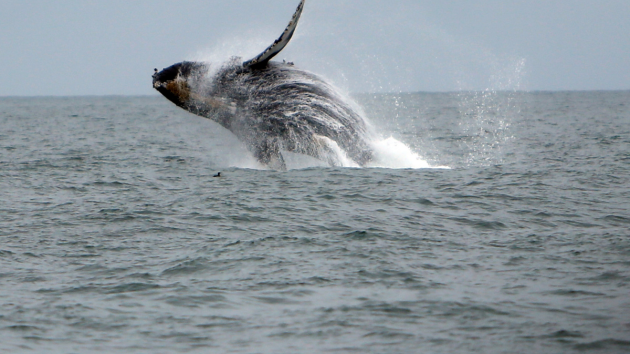
(SAN FRANCISCO, Calif.) -- Nearly two dozen whales have died in the San Francisco Bay Area in recent months, according to animal rescue groups.
A total of 19 gray whales, two unidentified baleen whales and one minke whale have died in the Bay Area region so far this year, according to the California Academy of Sciences.
At least seven of the gray whale deaths have been determined to be suspect or probable vessel strikes, according to the organization.
In addition, there has been an "unusually high" number of whale sightings in the Bay Area this year, with more than 30 individual gray whales confirmed in the region via photo identification, the Academy said, noting that the whales' physical conditions have ranged from normal to emaciated.
About a third of the whales have stayed in the region for at least 20 days and researchers expect more sightings for another couple of weeks before the whales migrate north to Arctic feeding grounds. The whales breed off the coast of Mexico but should be farther north at this time of year, Kathi George, director of cetacean conservation biology at The Marine Mammal Center in Sausalito, Calif., told ABC News.
In 2024, just six gray whales were sighted in the region. Researchers are investigating the potential reasons behind the "massive" spike in sightings this year.
Animal rescue groups in the region have not responded to this many dead gray whale deaths since the unusual mortality event in 2019 that saw more than 70 gray whale deaths on the West Coast, and another event in 2021 in which 15 whales died in the Bay Area, according to the California Academy of Sciences.
An estimated 45% of the North Pacific gray whale population was lost between 2019 and 2023, the California Academy of Sciences said.
In previous unusual mortality events, the gray whale population has typically rebounded but after 2019, the populations have experienced continued declines, George said. The population was estimated to be at nearly 27,000 in 2016 but fell to as low as 13,230 animals in the winter of 2022-2023 as a result of the mass mortality event, according to the National Oceanic and Atmospheric Administration (NOAA).
Marine researchers in the U.S., Mexico and Canada are monitoring the health of the gray whale population in hopes of gaining further insights into the unusual mortality event, the organization said.
Earlier this year, scientists in Southern California have reported a record-low gray whale calf count, "which is a cause for concern," according to the Academy.
Only about 85 gray whale calves migrated past Central California on their way to feeding grounds in the Arctic earlier this year, according to NOAA.
"It shows signs of concern for this population as it moves forward into the future," George said. "What we're trying to learn is we know that climate change is changing ocean conditions and changing prey available availability for these whales in the Arctic."
The Bay Area serves as a "puzzle piece" to the gray whales' lengthy annual migration, George said.
Dead whales have been reported in the San Francisco Bay Area since March 30, when a female gray whale was found dead at Black Sands Beach, located in the Golden Gate National Recreation Area. The animal died from a probable vessel strike, according to The Marine Mammal Center.
In May, six gray whales died in the region within a week.
The latest death occurred on July 7 at the Richmond Long Wharf, located about 20 miles north of San Francisco, according to The Marine Mammal Center. A dead female adult gray whale washed up adjacent to the Richmond-San Rafael Bridge after suffering from blunt force trauma by a suspected vessel strike, the organization said.
A necropsy revealed hemorrhaging on the animal’s left side, between the head and pectoral fin, likely as a result of the strike, according to the Center.
"This latest gray whale caught everyone a bit by surprise given how late in the season it is and the fact that we had not sighted the species in the bay in nearly two weeks," George said in a statement.
An estimated 80 whales die annually from vessel strikes, according to the Center for Biological Diversity.
Gray whales typically have a "very low profile" in the water that can make them difficult to see, unlike other coastal whales, such as humpback whales, according to the Academy.
"It’s vital that all boaters – from large commercial vessels to sailboats – be 'whale aware' and continue to slow down," the California Academy of Sciences said.
Further south, thousands of marine animals have been sickened by an unprecedented toxic algae bloom that has overrun the Southern California coasts.
Species such as seabirds, sea lions and dolphins have been impacted by elevated levels of the neurotoxic domoic acid produced by the algae blooms in the region. However, the harmful algae blooms aren't related to the recent whale deaths in the Bay Area because gray whales transiting north don't stop in Southern California to feed, George said.
"That is something we test for, though, when we are doing he necropsies – to see what they may have been exposed to recently," she said.